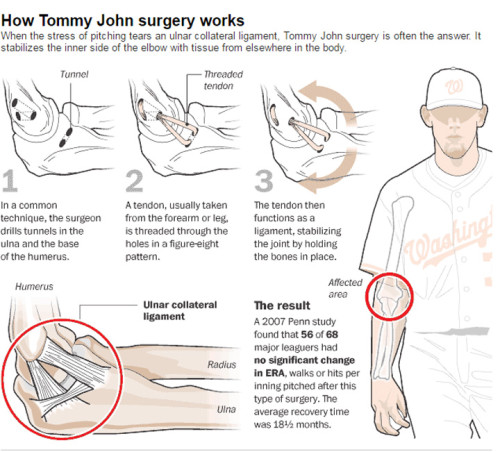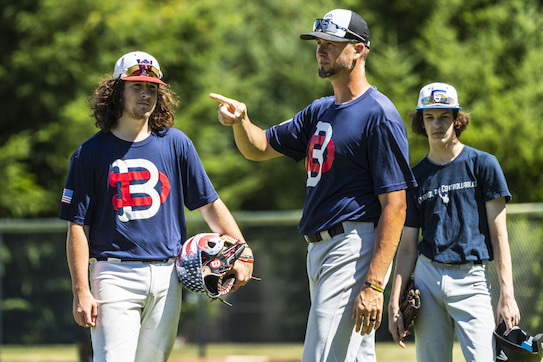EDUCATION IS KEY…

**Before you start working your way down the information on this page, please understand it is not meant to scare you. This information is gathered and put together to help educate you to be better prepared to help your ball player achieve their goals on the field while staying healthy along the way.**
The number of arm injuries in youth baseball pitchers has become so extreme that it is now referred to as an Epidemic! The most recent information shows that athletes between the ages 15-19 years old are needing more Tommy John procedures than any other age group. Even worse, we are seeing the number of these procedures increase at a rate of 9% per year.
This is a major problem that needs to be fixed. Change needs to be made to the current culture and ways of youth baseball. Regulations and guidelines will need to be implemented. The biggest issue here though is that for this to happen, it would require adults making the changes which unfortunately is the issue in the first place. Children are breaking because of how the adults, coaches AND parents, are choosing to use them. It’s going to take those in charge putting their foot down and establishing limits while placing people in place to monitor games and events to keep the adults accountable.
From Little League coaches to High School coaches to College coaches and everywhere in-between, change needs to happen. Many look to blame the lack of pitch counts on the issue but truth is, they are just a small part. Here is a list of issues that may lead to fatigue in pitchers which can ultimately lead to major injury when repeatedly done and/or ignored…
- Competing and throwing the baseball year round.
- Too many throws, too many pitches thrown, over a 2-3 day period.
- Lack of adequate recovery time for the arm.
- Pitching back to back days.
- Pitching in multiple games in the same day multiple days in a row.
- Playing for multiple teams and pitching for multiple teams at the same time.
- Poor throwing mechanics.
- Pitching and catching in the same game or the same day.
- Throwing a high amount of pitches one day and then catching a high amount of pitches the next day and vice versa.
- Catching too many innings/pitches in a single day or weekend.
- Throwing more pitches than what their arm/body is conditioned for.
- Throwing with an intensity that their arm is not conditioned for.
- Too little throwing between competitive performances.
- Too much time off between competitive performances.
- Throwing a high number of pitches and then playing a position later in the same day.
- Forcing the body to throw harder than what it is capable of.
- Underdeveloped bodies/throwing arms being pushed to try and withstand the workload of a mature pitching arm.
- Playing an excessive amount of baseball and lacking an arm care/maintenance program.
- Following inning limits and not pitch count limits.
- Participating in winter camps and showcases where radar guns are present when their arm is not prepared for the intensity and effort given when they know a radar gun is on them.
Let’s be real though, injuries happen. Throwing something overhand puts a lot of stress on the shoulder and elbow joints. Coordination and genetics can often play a role in a sore arm and eventually lead to an injury but the fact is, around the year 2000, injuries in youth and professional pitchers sky rocketed. Coincidence…Most likely not. That is about the same time that travel/tournament baseball took over and our youth started playing more and more games at younger and younger ages. Pre teens and young teens playing upwards of 60, 70 and 80+ games in a spring and summer season, then playing baseball in the fall month and then in the warmer climates, playing winter baseball.
Here is an ongoing list of Tommy John Surgeries (not counting other major pitching arm injuries that stem from misuse) in professional baseball ONLY dating back to the very first one in 1974.

Our Recommendations…
Yes, we are conservative but when players who are not even old enough to drive yet are playing 60-70-80+ games in a season, we feel you need to be. Yes, decisions should be determined by more than what some pitch count chart says but if you are inexperienced in this area and lack feel and instincts simply because you haven’t been around it enough, then use them to help you make choices and create a plan.
- Train with an emphasis on proper, sound, mechanics in their pitching delivery/throwing motion.
- NEVER pitch twice in the same day.
- Stay away from pitching back to back days.
- Follow warm up and throwing programs/routines during the off season and in season.
- Find an arm care plan you like and make it a part of your DAILY routine.
- Use the winter months to focus on strength and conditioning and devote time to mental strength skills.
- Train to get the most out of a pitchers body but never forget their job is to throw strikes.
- Set a rotation and stick to it.
- Limit a player to the DH position or let them sit the bench for the rest of the day after a long, high pitch count, performance.
- Make decisions based on what’s best for the players mental and physical health.
- Encourage young athletes to play multiple sports.
- Parents, set pitch count and inning limits. For the day, for the weekend and for the season. YOU keep track and be firm with these numbers and communicate with your coach.
- Coaches, make decisions based on what’s best for the athlete and their future.
- A coach should never ask Mom and Dad for permission to do what they already know shouldn’t happen because they want to take that decision off your back. This is their responsibility. Coaches must start taking accountability for these decisions and stop trying to pass it onto someone else.
Click here to view and download the PDF version of our Pitch Count Recommendations
In an effort to give you more information, below you will see links to various articles, ours and from other resources, our recommended websites and multiple videos for you to watch on the topic. We will also gather testimonials and real life stories for you to learn from.
Baseball Dudes Articles:
13 Ways To Protect Your Pitchers From Injury
What Are They Conditioned For?
Other Sources…Articles:
Wikipedia…Ulnar Collateral Ligament Reconstruction
Recommended Websites:
Videos:
**Please note, this page will be a constant work in progress to provide the most recent information. Please check back from time to time for updates.**







